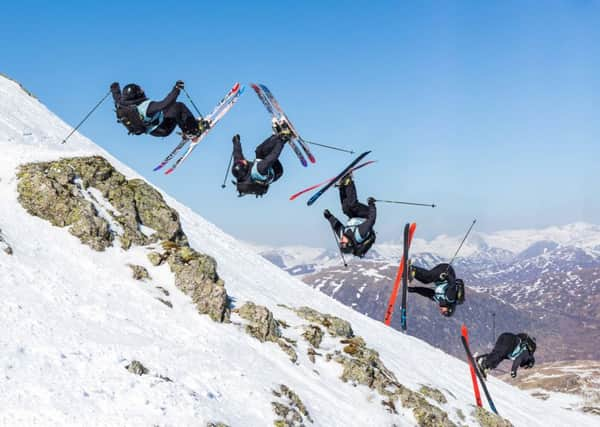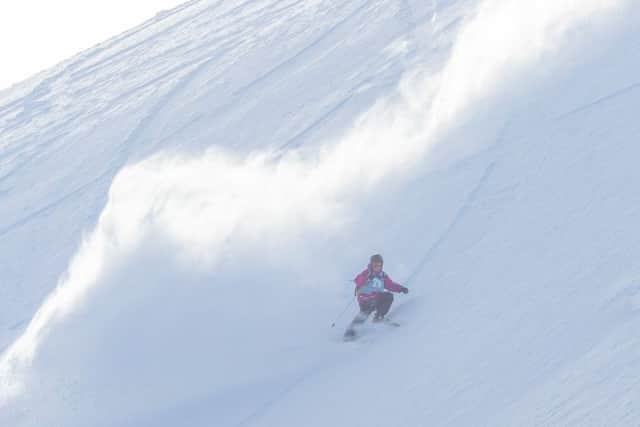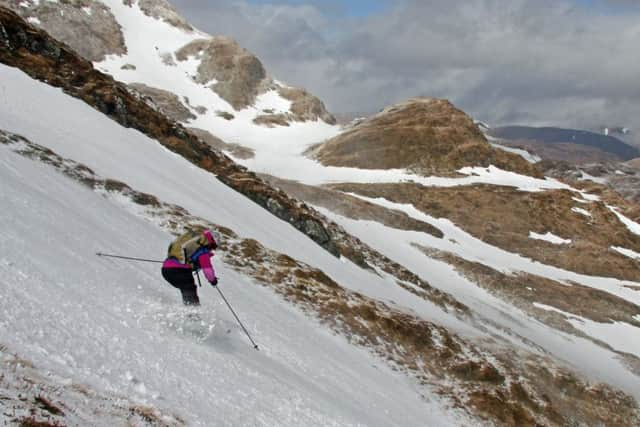Peter Mackenzie: What it’s like to go extreme skiing in Scotland
This article contains affiliate links. We may earn a small commission on items purchased through this article, but that does not affect our editorial judgement.


CLAMBERING down a partially frozen buttress on the north-east face of Meall a’Bhuiridh, looking for the entrance to my line, I spy Dave Biggin, last year’s Coe Cup winner, silently gazing into the middle distance, mentally preparing for his next drop. Yesterday, he hucked an improbable 20ft cliff, launching high-speed from the take-off, clearing almost as much horizontal rock as he did vertical, landing straight into his next turn and setting the bar several notches higher for the rest of us. It was a drop that no-one else had even considered, but then again this is Dave Biggin – there’s a good reason why he came first in the skiers’ category for the first three years of Glencoe’s freeride contest, and why his name is on the Coe Cup more than anyone else’s. But today, for the first time in three seasons, Dave is sitting in second place.
Internationally, competitive freeride skiing, also known as extreme skiing, is nothing new – since the early 90s events like this have been held across the skiing and boarding world. Participants are dropped at, or hike to, the top of a steep, rugged, untracked mountain face and take it in turns to descend through challenging terrain, each being free to interpret and ride the mountain as they wish, picking their own line according to appetite for risk and – hopefully – respect for nature and their own personal limits.
Advertisement
Hide AdAdvertisement
Hide AdInspection is bottom-up only, meaning there’s no practising, and every run has to be hit clean on sight. A competitor’s ride is judged according to a series of categories, including choice of line, use of natural features, control and technique, fluidity, jumps and style, giving an overall score which can be compared to their peers.


On the world stage, the masterclass competitions of the Freeride World Tour take place at famous big-mountain venues like Chamonix and Verbier. The Tour has launched the careers of countless professional skiers and boarders and has a slick media operation, complete with a YouTube channel boasting almost nine million views. To qualify for the tour, however, a rider first has to earn his stripes with enough points accumulated at Freeride World Qualifiers, or FWQs.
The FWQs take place at mountain destinations across the globe, including Tignes in France, Crested Butte in the US, Treble Cone in New Zealand, and – since 2013 – Glencoe in Scotland.
For those who know Scottish skiing, the thought of organising a freeride competition in the Highlands might seem bonkers, but with the cold winters the UK has been experiencing over the last decade, backcountry snowsports are having a bit of a renaissance in these parts.
In the winter of 2013/14, this led to the creation of the Freedom Series, Scotland’s answer to the Freeride World Tour, with competitions held all around the Highlands. In the first season, there were four events: the Glenshee Piste Off, the Cairngorm Freeride, the Nevis Corrie Challenge and the Coe Cup (the latter counting towards both the FWQ and the Freedom Series). Last season, due to cancellations, there were just three events: the Coe Cup, the Corries Challenge and the Lawers of Gravity – a hike and ride event in the Ben Lawers range, on the north shore of Loch Tay.


Because the Freedom Series is still so small, a good result at Glencoe is essential if you’re serious about winning the overall title. As Dave and I wait our turn at the top of the hill, I ask if he’s feeling nervous.
“Nervous? I’m almost hoping I don’t win – it’ll take the pressure off for next year…”
In the end, our lines are pretty similar, the crux of each a six-metre buttress off to the lookers’ left. I hit it to the right, airing straight from the top, but Dave launches leftwards off the top ramp, touching down on an exposed ledge midway down, before hammering straight into a high-speed second air to clear the whole buttress – a far more ambitious and consequential line, in which he has to nail that first landing or face tumbling off the second drop.
Advertisement
Hide AdAdvertisement
Hide AdFelix-Franz Prankl, an Austrian exchange student at UHI in Fort William, wows the judges with a backflip for fourth place, but overall his line lacks the sustained interest of Dave’s effort. Just when it seems Dave has the win in the bag, however, up steps Robert Kingsland, an Edinburgh Uni student and former freestyler who has been leading since day one. He hits Dave’s big double, but launches into it from behind off an extra notch right at the top of the line, leaving himself no margin for error, yet landing perfectly into a sweeping turn to line himself up for the main feature.
Kingsland, then, becomes the man to beat going into the next event: the Corries Challenge, held in the legendary Back Corries of the Nevis Range, one week later.
This second stop on the tour takes the riders onto the less skied area of steep terrain between Chancers and the Nid Ridge – like all the lines in the Back Corries, it’s steepest at the top, but mellows throughout its length, allowing the riders to see their whole runs right from the start gate and the judges to spy the whole face. The riders’ first lines get them a score and a ranking which determines whether they make the cut for the top eight and thus for the second round, cranking the pressure up right from the get-go.
Competition is fierce: Biggin, from Fort William, has the home advantage; Prankl’s creative airs and tidy form put him firmly in contention; Kingsland is leading the series; and Jamie Adcock is laying on the freestyle flare in the big mountain terrain. Once again, the skies are impossibly blue, and there’s plenty of snow about, but as the sun that has been softening this east face all morning gradually turns away, things start firming up quickly.
We watch from the top as Rob and Dave both scratch across the icy top section, edges chattering. Once again they both hit the same feature on the face – an hourglass-shaped section, where snow above and snow below don’t quite meet, hemmed in by rocks on both sides. Each carries just enough momentum to clear the mid-section, but only just – not a line for the timid. Dave, king of the big jumps, goes bigger, but lower down he gets lost in a boulder field and ends up on the rocks with nowhere to go.
Jamie goes hard-and-fast down the steepest part of the face for third, and Rob’s line earns him second, enough to keep him on top of the series. Felix’s big 360 off the entrance cornice, however, together with a fluid linking of lots of smaller features, leaves the judges in no doubt as to who’s won. With his 1-2, Rob is still leading, but the series is looking tight.
The mountains of the Ben Lawers Range became a popular ski venue in the 1930s, and though 1950s dreams of a ski lift there never materialised, the combination of a high access road and relatively snow-sure slopes means it’s still a darling of the ski-touring fraternity. With the blessing of the landowner, the National Trust for Scotland, the steep sides and undulating, rideable terrain of Meall nan Tarmachan were chosen for the final stop on the tour. Both upper and middle-mountain areas offer excellent potential competition terrain, giving options in case of poor snow down low, or rough weather up high.
On the day, the Lawers of Gravity serves up a “worst of both worlds” scenario – high winds and poor snow-cover. But a bit of grass-skiing doesn’t put off the usual suspects. Dave’s line says it all – straight-lining over eight metres of grass to a four metre drop back onto the snow, followed by what Rob describes as an “unskiable line” – over grass into a snow-chute less than a ski-length wide, off a sizeable cliff and onto a similar patch of snow, before crossing more grass and then regaining the snow below. He might have won it, but an uncharacteristic stumble on a lesser section of grass-hucking costs him dearly. Rob finds a snowpatch-kicker to launch him over a gushing waterfall on to the snow below for third place. Felix links grass take-offs with snow landings for second; but Jamie takes first with a series of bold, high-speed airs.With the series points totted up, Rob comes out tops, just ahead of Felix and Jamie, and despite a run of poor luck, Dave still finishes a respectable fourth.
Advertisement
Hide AdAdvertisement
Hide AdThey say, though, that the best skier on the mountain is the one who’s having the most fun, so perhaps the biggest winner was Tim Regan – a Londoner in his 50s who came all the way north just for the Coe Cup and the Corrie Challenge. Among the finishers at the Coe Cup, he came last, but more importantly, he loved it. As he put it: “I was first in the over-50s category!” ✱
Twitter: @thephmack
For details of this year’s Freedom Series, visit freedomseries.wix.com/freedomseries. Peter MacKenzie is the Highland freeskier behind the Dividing Line Invitational contest, and is supported by Whitedot Skis, Salewa, Craigdon Mountain Sports, Dirty Dog Eyewear, Adele Bergzauber, Buff, G3 and Nanox – follow his adventures at thephmack.com